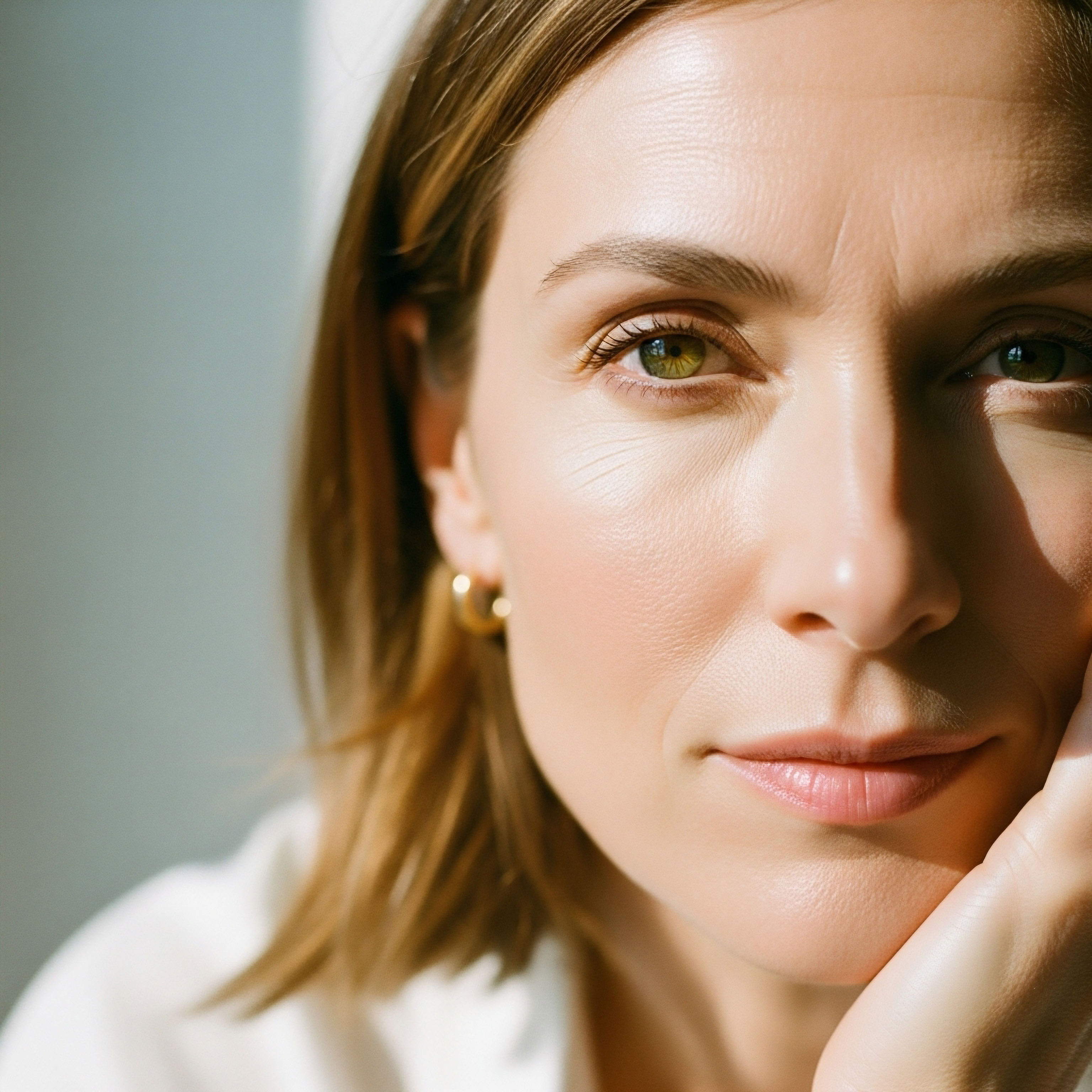

Fundamentals
You have begun a protocol of hormonal optimization, a significant step toward reclaiming your body’s intended function and vitality. You feel the initial shifts, the welcome return of energy or the subtle firming of muscle. Yet, at some point, the progress may seem to decelerate.
You might question if the protocol is still working, or if the dosage needs adjustment. The answer, in many cases, lies within the intricate biological environment that the therapeutic hormones enter. The success of any hormonal optimization protocol for body composition is profoundly influenced by the daily choices that govern your internal world. These choices are the powerful dialogue you have with your own physiology.
Think of your prescribed hormones, such as testosterone, as keys delivered to your body. Their purpose is to unlock specific cellular machinery that governs muscle growth, fat metabolism, and overall energy. However, the number of locks available on the cell surfaces, and how well those locks function, is directly shaped by your lifestyle.
Your body, in its immense wisdom, will not build and maintain metabolically expensive tissue like muscle unless it receives consistent signals that this tissue is necessary and that the resources exist to support it. Lifestyle provides these exact signals.
Lifestyle choices create the biological environment that determines how effectively your body can utilize the benefits of hormonal optimization therapy.

The Cellular Locks and Keys
At the heart of hormonal communication are receptors, which are specialized proteins on or inside your cells. For testosterone to exert its effects on muscle, for instance, it must first bind to an androgen receptor. The hormone is the key; the receptor is the lock.
A therapeutic protocol can supply an abundance of keys, yet if the number of locks is limited, or if they are functionally impaired, the message cannot be fully received. This is where your actions create profound biological change.
Resistance training is a primary stimulus for increasing the density of androgen receptors in your muscle tissue. When you lift weights, you create a demand that signals to the muscle cells that they need to become more sensitive to anabolic signals. In response, the cells synthesize more androgen receptors, effectively installing more locks.
Now, the testosterone provided by your therapy has more places to bind, amplifying its muscle-building signal. This is a direct physical adaptation that makes your body more efficient at using the very hormones you are supplementing. Without this stimulus, the hormonal potential remains just that, potential.

Controlling the Messengers
Another layer of control involves how hormones travel through your bloodstream. Many hormones, including testosterone, are bound to proteins, the most significant of which is Sex Hormone-Binding Globulin (SHBG). When a hormone is bound to SHBG, it is inactive and unavailable to the cell. Only “free” testosterone can enter cells and bind to receptors. Your lifestyle, particularly your nutritional habits, has a direct impact on SHBG levels.
For instance, diets with adequate protein content have been shown to correlate with lower levels of SHBG. This means more of your total testosterone is in a free, bioavailable state, ready to interact with your cells. Conversely, very low-calorie diets or certain nutritional deficiencies can cause SHBG levels to rise, effectively locking away a larger portion of your active hormones.
Your dietary choices therefore act as a master regulator, determining what percentage of the keys are available to unlock the cellular machinery for improving body composition.


Intermediate
Advancing beyond the foundational understanding that lifestyle matters, we arrive at a more granular, systems-based perspective. Sustaining the benefits of hormonal optimization requires a strategic approach that addresses the specific biological pathways your daily habits influence. The interconnectedness of your endocrine, metabolic, and nervous systems means that a targeted action in one area produces cascading effects throughout the body.
The goal is to cultivate an internal state of high receptivity, where every physiological system is primed to work in concert with your therapeutic protocol.

Precision Nutrition for Hormonal Efficiency
Your diet provides the raw materials not just for energy, but for the complex machinery of hormone synthesis, transport, and reception. Moving beyond simple macronutrient targets allows for a more sophisticated modulation of your endocrine environment.

The Role of Micronutrients
Specific vitamins and minerals are indispensable co-factors in hormonal pathways. Their presence or absence can dictate the efficiency of your entire endocrine axis.
- Zinc ∞ This trace mineral is essential for the very production of testosterone. It also plays a role in supporting the structural integrity and function of androgen receptors.
A deficiency can impair both hormone production and the cell’s ability to respond to it.
- Magnesium ∞ Working in concert with other nutrients, magnesium is involved in hundreds of enzymatic reactions, including those related to insulin sensitivity and testosterone production.
It can also influence SHBG levels, contributing to a greater availability of free testosterone.
- Vitamin D ∞ Functioning more like a pro-hormone than a vitamin, Vitamin D receptors are found on cells throughout the body, including in endocrine tissues. Adequate levels are associated with healthy testosterone production and improved insulin sensitivity, creating a more favorable metabolic environment for body composition changes.

Modulating SHBG and the Gut Microbiome
The amount of bioavailable hormone is a critical variable that is directly influenced by diet. The table below outlines key nutritional strategies for managing SHBG. Furthermore, the health of your gut microbiome, specifically a collection of bacteria known as the estrobolome, plays a significant role in metabolizing and clearing estrogens.
For men on TRT, preventing the excessive conversion of testosterone to estrogen (aromatization) is key. A healthy gut supports proper estrogen excretion, which can help maintain a balanced testosterone-to-estrogen ratio.
| Nutritional Factor | Impact on SHBG | Mechanism and Rationale |
|---|---|---|
| Protein Intake | Decreases SHBG |
Higher protein diets are associated with lower SHBG concentrations, increasing the proportion of free, bioavailable testosterone. This is also critical for providing the building blocks for muscle protein synthesis. |
| Fiber Intake | Increases SHBG |
High-fiber diets, while beneficial for gut health, have been shown to increase SHBG levels. This requires a balanced approach, ensuring adequate fiber for digestive health without excessively elevating SHBG. |
| Caloric Intake | Varies |
Severe caloric restriction can significantly increase SHBG, which is a protective mechanism during periods of low energy availability. A diet that supports your metabolic needs is essential for maintaining optimal hormone bioavailability. |
| Alcohol Consumption | Increases SHBG |
Chronic or excessive alcohol intake can elevate SHBG levels and place a burden on the liver, which is the primary site of SHBG production, thereby reducing free testosterone. |

Strategic Exercise for Systemic Adaptation
Physical activity is a potent modulator of the endocrine system. Different types of exercise elicit distinct hormonal and cellular responses. A well-designed program leverages these differences to create a powerful synergistic effect with hormonal therapy.
A comprehensive exercise regimen improves both hormonal signaling and the metabolic environment required for optimal body composition.

Resistance and Aerobic Training Effects
Resistance and aerobic training are not interchangeable; they are complementary tools that optimize different aspects of your physiology. Resistance training is the primary driver of androgen receptor upregulation, making your muscles more sensitive to testosterone’s anabolic signals. Aerobic exercise, on the other hand, is exceptionally effective at improving insulin sensitivity.
High insulin sensitivity means your body is efficient at managing blood glucose, preventing the metabolic dysfunction that can lead to fat storage and inflammation, both of which can counteract the benefits of hormonal therapy.
| Exercise Modality | Primary Hormonal/Metabolic Impact | Application for Body Composition |
|---|---|---|
| Heavy Resistance Training |
Increases androgen receptor density in muscle tissue. |
Maximizes the muscle-building (anabolic) effect of testosterone by improving cellular sensitivity to the hormone. |
| High-Intensity Interval Training (HIIT) |
Potently improves insulin sensitivity and stimulates growth hormone release. |
Enhances the body’s ability to partition nutrients toward muscle and away from fat storage. Can be taxing and requires adequate recovery. |
| Low-Intensity Steady-State (LISS) Cardio |
Improves mitochondrial function and reduces baseline cortisol. |
Builds aerobic base, aids recovery, and helps manage the stress response, creating a more favorable environment for anabolism. |

The Sleep and Stress Axis
Sleep is not a passive state; it is a critical period of hormonal regulation and physiological repair. Chronic sleep deprivation disrupts the natural rhythm of the Hypothalamic-Pituitary-Adrenal (HPA) axis, leading to chronically elevated levels of the stress hormone, cortisol.
Elevated cortisol is directly antagonistic to the goals of hormonal optimization. It promotes muscle breakdown (catabolism), encourages the storage of visceral fat, and induces insulin resistance. Perhaps most directly, cortisol can compete with testosterone for binding to androgen receptors, effectively dampening testosterone’s signal at the cellular level.
Managing stress through adequate sleep (7-9 hours per night) and mindfulness practices is therefore a non-negotiable component of any successful body composition protocol. It ensures that the catabolic influence of cortisol does not undermine the anabolic signals you are working to amplify.


Academic
A sophisticated analysis of sustaining the benefits of hormonal optimization reveals that the central mediating factor is the concept of cellular responsiveness. The introduction of exogenous hormones through therapies like TRT or the stimulation of endogenous production via peptides addresses only one variable ∞ ligand availability.
The ultimate phenotypic outcome, specifically the enhancement of lean body mass and reduction of adiposity, is contingent upon the body’s capacity to sense and transduce these hormonal signals effectively. This capacity is governed by a complex interplay of genetic predispositions and, most powerfully, by lifestyle-mediated modifications to the cellular environment. Lifestyle, therefore, functions as the primary regulator of the physiological gain on the hormonal signal.

Endocrine Resistance a Consequence of Chronic Inflammation
A state of chronic, low-grade inflammation, often stemming from a sedentary lifestyle, poor diet, or chronic stress, creates systemic interference that blunts hormonal signaling, a phenomenon that can be described as endocrine resistance. This state is perpetuated by inflammatory cytokines, such as TNF-α and IL-6, which can disrupt intracellular signaling cascades downstream of the hormone-receptor binding event.

How Does Inflammation Disrupt Hormonal Signaling?
Inflammation interferes with hormonal pathways through several mechanisms. Inflammatory cytokines can directly suppress the expression of hormone receptors, including the androgen receptor. They can also activate pathways, such as the NF-κB pathway, which promote a catabolic state and interfere with the anabolic signaling initiated by hormones like testosterone and growth hormone. This creates a cellular environment where the hormonal signal, even if present in supraphysiological amounts, is met with intracellular resistance.
Adipose tissue, particularly visceral fat, is a significant source of these pro-inflammatory cytokines. An unhealthy lifestyle promotes the accumulation of this metabolically active fat, which then secretes adipokines that perpetuate systemic inflammation and insulin resistance.
This establishes a vicious cycle where lifestyle-driven inflammation leads to hormonal resistance, which in turn makes it more difficult to improve body composition, further fueling the inflammatory state. Sustaining the benefits of hormonal therapy requires breaking this cycle by actively managing inflammation through diet, exercise, and stress reduction.

Molecular Adaptations to Resistance Exercise
The recommendation of resistance training for individuals on hormonal optimization protocols is grounded in its profound effects on the molecular biology of the target tissues, primarily skeletal muscle. The mechanical tension and metabolic stress generated during intense exercise initiate a cascade of events that culminates in an increased expression of the androgen receptor (AR) gene.

What Is the Mechanism for AR Upregulation?
Studies demonstrate that the intramuscular content of androgen receptors is a more robust predictor of hypertrophic response to training than circulating levels of testosterone itself. This underscores the importance of cellular preparedness. Resistance exercise activates signaling networks, including the mTOR pathway, which is a central regulator of cell growth.
These pathways lead to the activation of transcription factors that bind to the promoter region of the AR gene, increasing its transcription into messenger RNA (mRNA) and subsequent translation into AR protein. The result is a greater density of functional androgen receptors within the muscle fiber, enhancing its sensitivity to circulating androgens.
Sequential bouts of resistance exercise have been shown to progressively increase AR expression, indicating a cumulative adaptive response. This adaptation makes the muscle cell a more efficient transducer of the anabolic signal provided by testosterone therapy.
- Mechanical Overload ∞ Lifting weights creates tension, which is sensed by mechanoreceptors in the muscle cell membrane.
- Signaling Cascade Activation ∞ This stimulus activates intracellular pathways like the MAPK and PI3K/Akt/mTOR pathways.
- Gene Transcription ∞ These pathways promote the activity of transcription factors that increase the expression of the androgen receptor gene.
- Increased Receptor Density ∞ The muscle cell synthesizes more androgen receptor proteins, making it more responsive to testosterone.

The Gut Microbiome a Central Metabolic Regulator
The gut microbiome has emerged as a critical regulator of systemic metabolic health and hormonal balance. Its influence extends far beyond local digestion, directly impacting the enterohepatic circulation of hormones and the body’s inflammatory status. The composition of the gut microbiota, shaped primarily by diet, can therefore significantly modulate the outcomes of hormonal therapies.

How Does the Estrobolome Affect Hormonal Balance?
The estrobolome is a collection of gut microbes possessing genes that encode for enzymes, such as β-glucuronidase, which can deconjugate estrogens in the gut. In the liver, estrogens are conjugated (made inactive) to prepare them for excretion.
When these conjugated estrogens enter the intestine, certain gut bacteria can cleave off the conjugate, reactivating the estrogen and allowing it to be reabsorbed into circulation. An unhealthy estrobolome, characterized by an overgrowth of β-glucuronidase-producing bacteria, can lead to excessive estrogen reactivation and reabsorption.
For a male on TRT, this can contribute to a higher systemic estrogen load, potentially exacerbating side effects and working against the desired body composition changes. For a female, it can disrupt the delicate balance of sex hormones. A lifestyle that promotes a healthy, diverse microbiome, rich in fiber and fermented foods, supports proper estrogen excretion and hormonal homeostasis.

References
- Longcope, C. et al. “Diet and sex hormone-binding globulin.” The Journal of Clinical Endocrinology & Metabolism, vol. 85, no. 1, 2000, pp. 293-296.
- Kraemer, William J. et al. “Growth Hormone(s), Testosterone, Insulin-Like Growth Factors, and Cortisol ∞ Roles and Integration for Cellular Development and Growth With Exercise.” Frontiers in Endocrinology, vol. 11, 2020, p. 33.
- Pilz, S. et al. “Effect of vitamin D supplementation on testosterone levels in men.” Hormone and Metabolic Research, vol. 43, no. 3, 2011, pp. 223-225.
- Vingren, J. L. et al. “Testosterone physiology in resistance exercise and training ∞ the up-stream regulatory elements.” Sports Medicine, vol. 40, no. 12, 2010, pp. 1037-1053.
- Campbell, Pippa. “3 Simple Ways to Lower Elevated SHBG Levels.” Pippa Campbell Health, 2023.
- Borghouts, L. B. and H. A. Keizer. “Exercise and insulin sensitivity ∞ a review.” International Journal of Sports Medicine, vol. 21, no. 1, 2000, pp. 1-12.
- Goodyear, L. J. and B. B. Kahn. “Exercise, glucose transport, and insulin sensitivity.” Annual Review of Medicine, vol. 49, 1998, pp. 235-261.
- Richter, Erik A. and Mark Hargreaves. “Exercise, GLUT4, and skeletal muscle glucose uptake.” Physiological Reviews, vol. 93, no. 3, 2013, pp. 993-1017.
- Simó, R. et al. “Human sex hormone-binding globulin does not provide metabolic protection against diet-induced obesity and dysglycemia in mice.” Endocrinology, vol. 153, no. 8, 2012, pp. 3777-3787.
- Selby, C. “Sex hormone binding globulin ∞ origin, function and clinical significance.” Annals of Clinical Biochemistry, vol. 27, no. 6, 1990, pp. 532-541.
- Pugeat, M. et al. “Regulation of sex hormone-binding globulin (SHBG) in humans.” Annals of Endocrinology, vol. 56, no. 4, 1995, pp. 337-343.
- Leproult, R. and E. Van Cauter. “Role of sleep and sleep loss in hormonal release and metabolism.” Endocrine Development, vol. 17, 2010, pp. 11-21.
- Parry, Barbara L. et al. “The influence of sex and gonadal hormones on sleep disorders.” Clocks & Sleep, vol. 2, no. 3, 2020, pp. 343-361.
- Steiger, A. “Sleep and the hypothalamo-pituitary-adrenocortical system.” Sleep Medicine Reviews, vol. 6, no. 2, 2002, pp. 125-138.
- Straub, Rainer H. “Interaction of the endocrine system with inflammation ∞ a function of energy and volume regulation.” Arthritis Research & Therapy, vol. 16, no. 2, 2014, p. 203.
- Saltiel, Alan R. and Jerrold M. Olefsky. “Inflammatory mechanisms linking obesity and metabolic disease.” The Journal of Clinical Investigation, vol. 127, no. 1, 2017, pp. 1-4.
- Ståhlberg, T. et al. “Intratumoural inflammation and endocrine resistance in breast cancer.” Endocrine-Related Cancer, vol. 22, no. 2, 2015, pp. R51-R67.
- Baker, J. M. et al. “Estrogen-gut microbiome axis ∞ Physiological and clinical implications.” Maturitas, vol. 103, 2017, pp. 45-53.
- Kwa, M. et al. “The Estrobolome ∞ The Gut Microbiome and Estrogen.” Journal of the National Cancer Institute, vol. 108, no. 8, 2016.
- Plottel, Claudia S. and Martin J. Blaser. “The estrobolome ∞ the gut microbiome and estrogen.” Journal of Medical Microbiology, vol. 60, no. 11, 2011, pp. 1551-1552.
- Willoughby, D. S. and L. Taylor. “Effects of sequential bouts of resistance exercise on androgen receptor expression.” Medicine and Science in Sports and Exercise, vol. 36, no. 9, 2004, pp. 1499-1506.
- Ahtiainen, J. P. et al. “Muscle androgen receptor content and muscle hypertrophy in women.” Journal of Steroid Biochemistry and Molecular Biology, vol. 93, no. 1, 2005, pp. 39-45.
- Morton, Robert W. et al. “Muscle Androgen Receptor Content but Not Systemic Hormones Is Associated With Resistance Training-Induced Skeletal Muscle Hypertrophy in Healthy, Young Men.” Frontiers in Physiology, vol. 9, 2018, p. 1373.
- McCall, G. E. et al. “Acute and chronic hormonal responses to resistance training designed to promote muscle hypertrophy.” Canadian Journal of Applied Physiology, vol. 24, no. 1, 1999, pp. 96-107.

Reflection
The information presented here provides a map of the biological terrain you inhabit. It details the pathways, the signals, and the systems that collectively determine your physical form and function. This knowledge is a powerful tool, shifting the perspective from one of passive recipient of a therapy to one of active architect of your own physiology.
The clinical protocols you may follow are potent catalysts for change. They open a window of opportunity. The durability and magnitude of the changes seen through that window are ultimately shaped by the environment you construct within yourself each day.

What Is the Next Step on Your Personal Health Journey?
Consider your own daily inputs. View your nutritional choices, your movement patterns, your sleep quality, and your stress responses not as separate obligations, but as integrated signals that inform your biology. Each meal, each workout, and each night of restorative sleep is a message sent to your cells, instructing them on how to respond to the hormonal environment.
The journey toward sustained vitality is one of continual learning and adaptation. The data from your own body, how you feel, perform, and look, is the most valuable feedback you will ever receive. Use this understanding as a lens through which to interpret that feedback, making informed adjustments to better align your actions with your goals.



